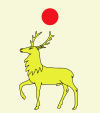گوريا
گوريا
გურია Guria | |
|---|---|
 | |
| البلد | |
| العاصمة | اُزورگتي |
| البلديات | 3 |
| المساحة | |
| • الإجمالي | 2٬033 كم² (785 ميل²) |
| التعداد (2014) | |
| • الإجمالي | 113٬221 |
| • الكثافة | 56/km2 (140/sq mi) |
| ISO 3166 code | GE-GU |
گوريا (بالجورجية: გურია؛ إنگليزية: Guria) هي منطقة (مخارى) في جورجيا، في الجزء الغربي من البلد، يحدها من الغرب البحر الأسود. تعداد المنطقة كان 113,221 (تعداد 2014) [1] وعاصمتها هي اُزورگتي.
الجغرافيا
Guria is bordered by Samegrelo to the north-west, Imereti to the north, سامتسخى-جڤاختي to the east, أجاريا to the south, and the البحر الأسود to the west. The province has an area of 2,033 كم².
Guria is traversed by the northeasterly line of equal latitude and longitude.
Guria consists of three municipalities:
التاريخ
The toponym "Guria" is first attested in the c. 800 Georgian chronicle of Pseudo-Juansher.[2]
Guria first appears c. 1352 as a fief of the house of Vardanidze-Dadiani; and after 1463 it became a sovereign principality independent of the Kingdom of Georgia under a branch of that house, known thereafter by the name of Gurieli. The principality, comprising modern Guria and much of Adjara with the city of Batumi, was subsequently reduced in size and devastated in a series of conflicts with the Ottoman Empire. A Russian protectorate was established by the treaty concluded on June 19, 1810 between the Gurieli Mamia V and the empire, and in 1829, during the regency for the last prince, the Gurieli David, the principality was annexed by Russia.[3]
There were uprisings against Russian rule in 1819 and again in 1841. In 1840, Guria was made a county (uyezd) and renamed Ozurgeti, after one of its main towns. In 1846, it was transferred to the new Kutais Governorate. By 1904, the population was just under 100,000, occupying an area of approximately 532,000 acres (2,150 km2) of mountains and swampy valleys, covered by corn fields, vineyards, and some tea plantations. It was the most ethnically homogenous of Georgian areas, with the peasantry and lesser rural nobility making up almost the entire population, with a high level of literacy and relatively high degree of economic self-satisfaction. The peasant protest movement, which originated in 1902 and culminated in an open insurrection against the government during the Russian Revolution of 1905, was the most effective and organized peasant movement in the empire. The peasants’ self-government, the so-called Gurian Republic, survived into 1906, when it was crashed and Guria devastated by the Cossack punitive expedition.[4] The region was a native powerbase of the Georgian Social Democratic (Menshevik) Party which dominated the Democratic Republic of Georgia from 1918 to 1921. Guria was a scene of guerrilla resistance to the militarily imposed Soviet rule early in the 1920s. Under the Soviet government, Guria was an agrarian area divided into three administrative districts. In 1995, the Georgian government decreed the creation of the region (mkhare) of Guria, restoring the province’s historical name to official usage.
The Orthodox churches of Likhauri and Shemokmedi are the main historical buildings in the province.
أصل الاسم "گوريا"
As for the etymology of the name of Guria, some say that the root of the word refers to restlessness and the word should mean “the land of the restless” and may be associated with events during the eighth and ninth centuries when “Leon became the King of Abkhazeti, Guruls refused to obey the ruler of Odzrakho, ceased their vassal relations with Adarnase and Ashot Bagrationi and united with Leon” as it was described in Vakhushti Bagrationi’s historical works of the eighteenth century.
According to a later explanation, in the times of Georgia’s prosperity, when its borders stretched from “Nikopsia to Daruband”, Guria was situated in the heart of the Georgian territory. The linguistic evidence for the above hypothesis is the Megrelian for “heart” – “guri”.
الاقتصاد
Subtropic farming and tourism is a mainstay of the region’s economy. Water is one of the Guria’s main assets. The province is famous for the mineral water of Nabeglavi, which is similar to Borjomi in its chemical composition and the Black Sea health resort of Ureki rich in magnetic sand. Guria is also one of the largest tea growing regions in Georgia. [1]
السكان
The Gurians or Gurulebi (Georgian: გურულები) is one of the ethnographical groups of Georgians, inhabiting Guria. Gurians are Orthodox Christian and speak the Gurian dialect of the Georgian language.[5]
أبرز سكانها
- Gabriel Kikodze, the Bishop of Imereti (nineteenth century).
- Ekvtime Takaishvili (1862-1952), historian.
- Noe Zhordania, Prime Minister of the Democratic Republic of Georgia from 1918 to 1921.
- Pavle Ingorokva (1893-1990), historian, philologist, and public benefactor.
- إدوارد شڤردنادزه، رئيس جورجيا الأسبق.
- Nodar Dumbadze, Writer.
انظر أيضاً
الهامش
- ^ Population of Georgia
- ^ Rapp, Stephen H. (2003), Studies In Medieval Georgian Historiography: Early Texts And Eurasian Contexts, p. 427. Peeters Bvba, ISBN 90-429-1318-5.
- ^ Yust, Walter (ed., 1952), The Encyclopaedia Britannica - A new survey of universal knowledge. Volume 14, p. 6.
- ^ Stephen F. Jones (2005), Socialism in Georgian Colors: The European Road to Social Democracy, 1883-1917, pp. 131-2. Harvard University Press, ISBN 0-674-01902-4.
- ^ http://www.encyclopedia123.com/G/Gurians.html
- Pages using gadget WikiMiniAtlas
- Short description is different from Wikidata
- Pages using infobox settlement with no coordinates
- Articles containing جورجية-language text
- Articles containing إنگليزية-language text
- Pages using Lang-xx templates
- Coordinates on Wikidata
- تاريخ جورجيا
- گوريا
- مناطق جورجيا
- مناطق تاريخية في جورجيا



